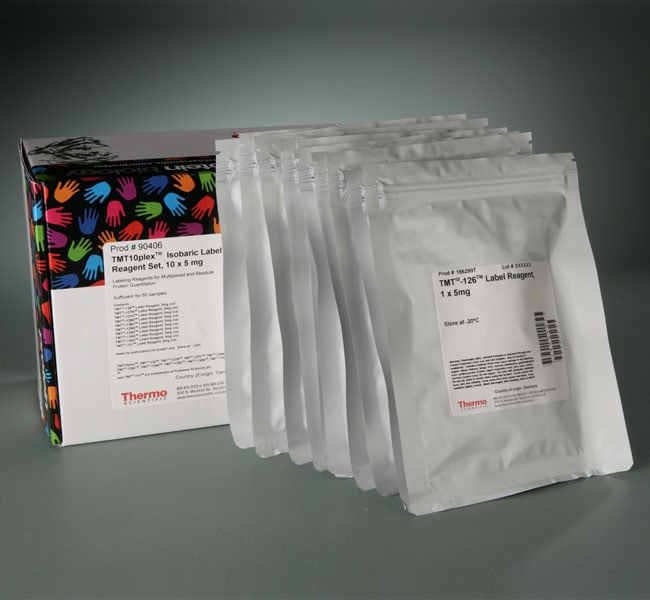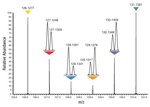Search Thermo Fisher Scientific
TMT10plex™ Isobaric Label Reagents and Kits
| Catalog Number | Quantity | Product Type |
|---|---|---|
| 90406 | 1 x 5 mg (per tag), 60 reactions | Isobaric Label Reagent Set |
| 90110 | 1 x 0.8 mg (per tag), 10 reactions | Isobaric Label Reagent Set |
| 90111 | 3 x 0.8 mg (per tag), 30 reactions | Isobaric Label Reagent Set |
| 90309 | 8 x 0.2 mg | Isobaric Label Reagent Set |
| 90113 | 3 x 0.8 mg | Isobaric Mass Tag Labeling Kit |
The Tandem Mass Tag (TMT) Isobaric Label reagents and kits are specifically designed to enable identification and quantitation of proteins in different samples using tandem mass spectrometry. The TMT10plex label reagents share an identical structure with TMTzero, TMTduplex, and TMTsixplex reagents, but contain different numbers and combinations of 13C and 15N isotopes in the mass reporter. The different isotopes result in a 10-plex set of tags that have mass differences in the reporter that can be detected using high resolution Orbitrap MS instruments.
Advantages of the TMT10plex label reagents include increased multiplex relative quantitation, increased sample throughput, and fewer missing quantitative values among samples. TMT10plex label reagents are ideal for analysis of multiple protein samples from inhibitor dose response experiments, time course experiments, or improving statistics on biological replicates.
Features of TMT10plex Isobaric Label reagent sets and mass tagging kits
• Powerful—multiplexed MS analysis increases sample throughput and enables relative quantitation of up to ten different samples derived from cells, tissues, or biological fluids
• Consistent—identical reagent structure and performance among TMTzero, TMTduplex, TMTsixplex, and TMT10plex reagents allows efficient transition from method development to multiplex quantitation, enabling biomarker discovery research across platforms and datasets
• Robust—increased multiplex capability results in fewer missing quantitative values among samples and higher confidence among replicates
• Efficient—amine-reactive, NHS-ester-activated reagents ensure efficient labeling of all peptides regardless of protein sequence or proteolytic enzyme specificity
• Compatible—optimized for use with high resolution Orbitrap MS/MS platforms, with data analysis fully supported by Proteome Discoverer 2.3.
Applications:
• Protein identification and quantitation from multiple samples of cells, tissue, or biological fluids
• Protein expression profiling of normal vs. disease states or control vs. treated
• Quantitative analysis of proteins for which no antibodies are available
• Identification and quantitation of membrane and post-translationally modified proteins
• Identification and quantification of hundreds to thousands of proteins in a single experiment
TMT Reagents are provided as standalone sets, a 96-well format, or in optimized kit formats containing all necessary reagents and controls for maximum flexibility, convenience, and reliability. When combined with the industry-leading, high resolution Thermo Scientific Orbitrap instruments and software, TMT10plex reagents provide integrated total solutions for quantitative protein expression analysis.
General References:
- Thompson, A., et al.(2003). Tandem mass tags: a novel quantification strategy for comparative analysis of complex protein mixtures by MS/MS. Anal. Chem.75(8), 1895-1904.
- Dayon, L., et al.(2008). Relative quantification of proteins in human cerebrospinal fluids by MS/MS using 6-plex isobaric tags. Anal. Chem. 80(8), 2921 -2931.
• TMT10-126 Label Reagent, 1 x 5 mg
• TMT10-127N Label Reagent, 1 x 5 mg
• TMT10-127C Label Reagent, 1 x 5 mg
• TMT10-128N Label Reagent, 1 x 5 mg
• TMT10-128C Label Reagent, 1 x 5 mg
• TMT10-129N Label Reagent, 1 x 5 mg
• TMT10-129C Label Reagent, 1 x 5 mg
• TMT10-130N Label Reagent, 1 x 5 mg
• TMT10-130C Label Reagent, 1 x 5 mg
• TMT10-131 Label Reagent, 1 x 5 mg
Store at –20°C.
Figures



Customers who viewed this item also viewed
Documents & Downloads
Certificates
Safety Data Sheets
Scientific Resources
Product Information
Limited Use Label Licenses (LULL)
The purchase of this product conveys to the buyer the non-exclusive, non-transferable right to use the product and components of the product for internal research purposes of the buyer only, whether the buyer is an academic or for-profit entity. This product is not available for use in diagnostic procedures.
The buyer must obtain a license for use of the product in performing commercial services or for any other commercial purposes. For information on purchasing a license, contact proteomics.licensing@thermofisher.com, Pierce Biotechnology, Inc., 3747 North Meridian Road, Rockford, IL 61101.
If the buyer is not willing to accept the limitations of this limited use statement, Pierce Biotechnology, Inc. is willing to accept return of the unused product with a full refund. By opening and using this product, the buyer agrees to be bound by the conditions of this Limited Use Label License.




